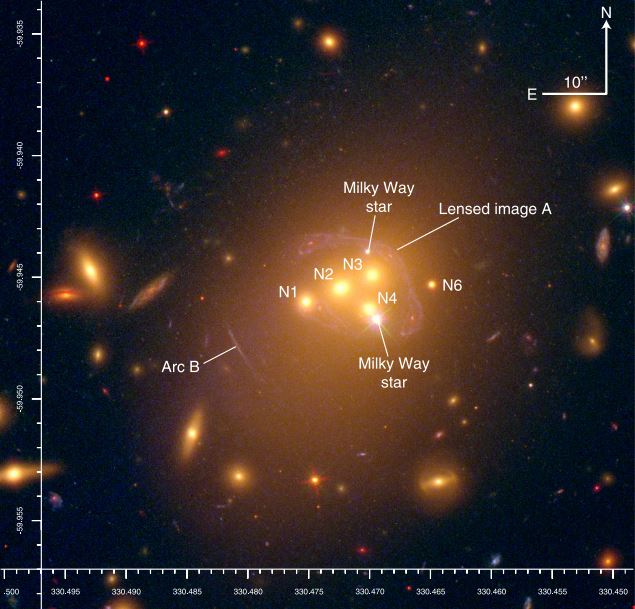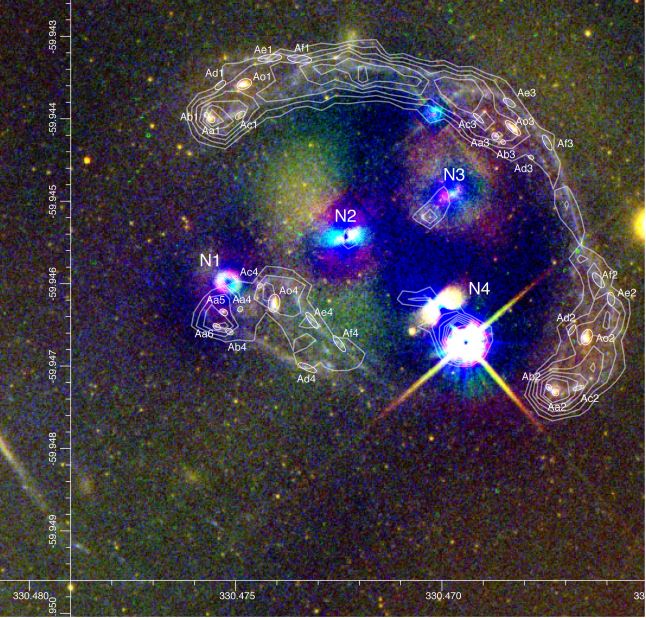Dark matter, something we cannot see with telescopes or detect with instruments, but know it is there because of its gravitational effects on visible matter, like stars and galaxies, may not be so ‘dark’ after all.
An international team of scientists from Belgium, France, South Africa, Switzerland, US and UK, led by researchers at Durham University reported signs of dark matter apparently interacting with a force other than gravity.
Their discovery was made while viewing simultaneous collisions of four far-away galaxies at the center of a galaxy cluster 1.3 billion light hears from Earth. They used observations from the Hubble Space Telescope and the European Southern Observatory’s Very Large Telescope.

HST image of galaxy cluster Abell 3827, showing the F606W (green), F160W (red), and F336W (blue) bands. The colour scale is logarithmic. Labels show the four bright (plus one faint) central galaxies, foreground stars and background lensed galaxies. (Image: mnras.oxfordjournals.org)
They reported their findings in the academic journal Monthly Notices of the Royal Astronomical Society.
Dr. Richard Massy, Royal Society Research Fellow in Durham University’s Institute for Computational Cosmology, and team noticed that one dark matter clump appeared to be lagging the galaxy it surrounded.
The authors wrote that the dark matter clump was offset from its galaxy by approximately 5,000 light years or 50,000 million million kilometres, i.e. a distance that would take the Voyager spacecraft more than 90 million years to travel.
For this kind of offset to occur, dark matter would have to interact with forces other than gravity, the scientists explained.
Additional friction would slow down dark matter
Computer simulations showed that the extra friction from the collision would slow down the dark matter, eventually forcing it to lag behind the galaxy it surrounds.
Astronomers believe that all galaxies in the Universe lie within clumps of dark matter. We call it ‘dark’ because it cannot be seen and only appears to interact with gravity.
Without dark matter’s gravitational pulling effect, galaxies including the Milky Way would not be able to spin, they would simply fling themselves apart.
The researchers in this latest study could ‘detect’ the presence of the dark matter clump because of its distortion of the background galaxies’ light – an effect known as gravitational lensing.
Dr. Massey and colleagues say their finding rules out the standard theory of Cold Dark Matter, which suggests that it only interacts with gravity.
Dr. Massey explained:
“We used to think that dark matter sits around, minding its own business. But if it slowed down during this collision, this could be the first dynamical evidence that dark matter notices the world around it.”
“Dark matter may not be completely ‘dark’ after all.”

HST image of the core of Abell 3827, with light from the four bright galaxies subtracted to reveal the background lens system. (Image: mnras.oxfordjournals.org)
The authors say that additional studies are required to rule out or include other potential causes for the lag between dark matter and the galaxy within it.
They added that other similar studies are currently underway, which they hope will confirm their interpretation.
Co-author, Lilya Williams, who works at the University of Minnesota, said:
“Our observation suggests that dark matter might be able to interact with more forces than just gravity.”
“The parallel Universe going on around us has just got interesting. The dark sector could contain rich physics and potentially complex behaviour.”
In another study, reported in March 2015, Dr. Massey and colleagues found that after studying 72 collisions between galaxy clusters, dark matter appeared not to interact at all with anything.
In this latest study, they looked at movements within individual galaxies. Scientists say the collision between the galaxies may have lasted longer than the ones examined in the previous study – allowing even a small frictional force to build up over time.
Dr. Massey said:
“We are finally homing in dark matter from above and below – squeezing our knowledge from two directions. Dark matter, we’re coming for you.”
The study was financed by The Leverhulme Trust, the Science & Technology Facilities Council, and the Royal Society.
Reference: “The behaviour of dark matter associated with four bright cluster galaxies in the 10 kpc core of Abell 3827.” Richard Massey, Holger Israel, Johan Richard, Liliya Williams, Matt Hilton, Renske Smit, Mark Swinbank, Thomas D. Kitching, Irshad Mohammed, David Harvey, Mathilde Jauzac, Douglas Clowe, Alastair Edge, Eric Jullo, Adrienne Leonard, Jori Liesenborgs, John Stott, Julian Merten, Daisuke Nagai, Andrew Robertson, Prasenjit Saha, Rebecca Santana and Eric Tittley. Monthly Notices of the Royal Astronomical Society. Published 14 April, 2015. DOI: 10.1093/mnras/stv467.
